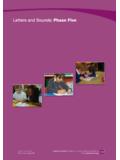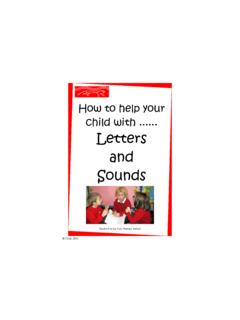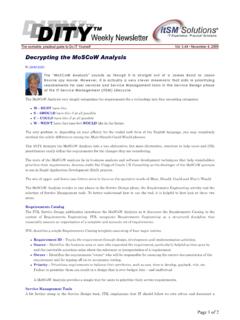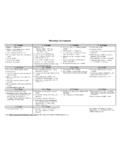Transcription of Phonics: assessment and tracking guidance
1 phonics : assessment and tracking guidance phonics : assessment and tracking guidance First published in 2009. Ref: 00906-2009 PDF-EN-01. Disclaimer The Department for Children, Schools and Families wishes to make it clear that the Department and its agents accept no responsibility for the actual content of any materials suggested as information sources in this publication, whether these are in the form of printed publications or on a website. In these materials, icons, logos, software products and websites are used for contextual and practical reasons. Their use should not be interpreted as an endorsement of particular companies or their products.
2 The websites referred to in these materials existed at the time of going to print. Please check all website references carefully to see if they have changed and substitute other references where appropriate. The National Strategies | Primary 1. phonics : assessment and tracking guidance Contents assessment in the Communication, Language and Literacy Development (CLLD) programme 3. 1. guidance on using the phonic progress tracking sheet 5. 2. assessment guidance for phonic Phases 2 5 6. 3. Assessing children's phonic skills and knowledge 11. 4. Assessing phonic skills and knowledge during shared, guided and independent reading and writing sessions 12.
3 5. Assessing grapheme phoneme correspondences individual assessment for occasional use 13. 6. Links between phonic phase assessment and EYFSP/APP 14. Crown copyright 2009 00906-2009 PDF-EN-01. The National Strategies | Primary 3. phonics : assessment and tracking guidance assessment in the Communication, Language and Literacy Development (CLLD). programme Systematic daily phonics teaching is a key element of the CLLD approach to the teaching of early literacy. Teachers need to feel confident about assessing children's command of phonic skills and knowledge if they are to plan effectively to meet all children's needs and to support them in becoming fluent, independent readers and writers.
4 By ensuring that teaching is adapted to support all children, teachers can be sure that all children make good progress and that vulnerable children are identified early and provided with support to enable them to catch up before the gap between them and their peers widens. In deciding when children are secure at phonic phases, teachers need to be thinking about what children know and can do when their attention is on phonics . This can be during the discrete daily phonics session, but will also be apparent during shared guided and independent reading and writing sessions. Writing samples provide useful evidence of children's phonic knowledge and ability to apply phonic skills, but evidence obtained through observation of children's approaches to reading unfamiliar words is of equal importance.
5 Some children need more encouragement than others to read and, particularly, write independently. It is important that teachers ensure that the environment is stimulating, resources inviting and adults ready to support children's independent reading and writing. However, it is not essential for children to demonstrate phonic skills and knowledge in independent contexts before moving on to the next phonic phase, as long as responses during the discrete daily phonics session and in guided reading and writing sessions confirm that they are confidently applying the skills and knowledge they have been taught. In Letters and Sounds the boundaries between the phases are deliberately porous so that no children are held back, or unduly pressured to move on before they are equipped to do so.
6 It follows that practitioners and teachers will need to make principled decisions based on reliable assessments of children's learning to inform planning for progression within and across the phases. (Letters and Sounds Notes of guidance for Practitioners and Teachers, p. 3). The following guidance materials will support teachers and practitioners in making judgements about children's progress through the phonic phases: 1. guidance on using the phonic progress tracking sheet 2. assessment guidance for phonic Phases 2 5. 3. Assessing children's phonic skills and knowledge 4. Assessing phonic skills and knowledge during shared, guided and independent reading and writing sessions 5.
7 Assessing grapheme phoneme correspondences individual assessment for occasional use. Teachers and practitioners should also be using assessments of phonic skills and knowledge to inform judgements against the Early Years Foundation Stage Profile (EYFSP) scale points and Assessing Pupils'. Progress (APP) guidelines. While there is no direct correlation between phonic phase attainment and EYFSP/APP, a judgement of secure at Phase 3', for example, would indicate that children should be able Crown copyright 2009 00906-2009 PDF-EN-01. 4 The National Strategies | Primary phonics : assessment and tracking guidance to apply the skills and knowledge associated with Phase 3 and this in turn should provide evidence towards certain EYFSP scale points/APP guidelines.
8 Further guidance and suggested possible links between EYFSP and APP can be found in the following section: 6. Links between phonic phase assessment and EYFSP/APP. All local authorities (LAs) should now have in post a dedicated CLLD consultant, so teachers and practitioners should be able to access further support and guidance on assessment at a local level. The Letters and Sounds: phonic progress tracking sheet can be found on The National Strategies area of the Standards site using ref 00617-2007 DWO-EN. 00906-2009 PDF-EN-01 Crown copyright 2009. The National Strategies | Primary 5. phonics : assessment and tracking guidance 1.
9 guidance on using the phonic progress tracking sheet The phonic progress tracking sheet is designed to provide an overview of children's progress through the phonic phases. Regular monitoring of the tracking sheet will allow teachers and managers to ensure that all children make expected progress, including children in the most vulnerable groups (search for the Letters and Sounds: phonic progress tracking sheet on The National Strategies area of the Standards site using ref 00617-2007 DWO-EN). Working on Teachers should enter children's names on the tracking sheet, under the appropriate half-term heading, as children begin working on a particular phase.
10 For example, the names of those children who begin working on Phase 2 in September should be written into the box alongside the Phase 2 descriptors and in the first autumn column. As children begin working on Phase 3, their names should be written alongside the Phase 3 descriptors and in the appropriate term' column. Secure at Children are judged to be secure at a particular phase once they know most of the phonemes associated with that phase most of the time, and can apply the skills of blending and segmenting using an appropriate range of grapheme phoneme correspondences. Many teachers have adopted a strategy of highlighting children's names once they are judged to be secure at that phase.


















